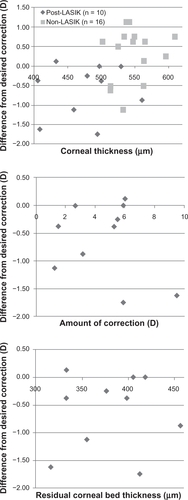Figures & data
Figure 1 Cylindrical change from preoperative for non- and post-LASIK groups. One week, 1 month, 3 months, 6 months, and 1 year postoperative absolute cylinder change from preoperative was calculated for the non- and post-LASIK groups.

Table 1 Nomogram for conductive keratoplasty
Figure 2 The error from the intended correction for non- and post-LASIK groups. The predictability at 1 week, 1 month, 3 months, 6 months, and 1 year postoperative for the non- and post-LASIK groups was evaluated by calculating the distance of manifest refraction spherical equivalent value from the intended correction.

